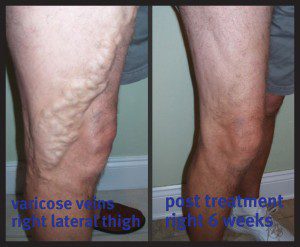By Joseph Magnant, MD, FACS –
 Jean, a 45 year old cath lab scrub tech had been suffering with progressive leg swelling for at least 15 years. Although she did have a history of varicose veins in her sister, she initially did not have any signs of varicose veins, and had been told by a number of medical professionals that her excess weight was the main problem. Compression hose offered temporary and incomplete relief. Exercise was difficult due to the heaviness, achiness and discomfort she had after standing all day in the cath lab. Other symptoms included heaviness in the legs, night time leg cramps and frequent nighttime urination. Ultrasound evaluation confirmed severe bilateral great saphenous vein insufficiency and subsequent radiofrequency endovenous ablation was performed on both legs 2 weeks apart with excellent results. She was seen for her 9 month follow-up the other day and was elated with the relief of her heaviness and resolution of her night time urination.
Jean, a 45 year old cath lab scrub tech had been suffering with progressive leg swelling for at least 15 years. Although she did have a history of varicose veins in her sister, she initially did not have any signs of varicose veins, and had been told by a number of medical professionals that her excess weight was the main problem. Compression hose offered temporary and incomplete relief. Exercise was difficult due to the heaviness, achiness and discomfort she had after standing all day in the cath lab. Other symptoms included heaviness in the legs, night time leg cramps and frequent nighttime urination. Ultrasound evaluation confirmed severe bilateral great saphenous vein insufficiency and subsequent radiofrequency endovenous ablation was performed on both legs 2 weeks apart with excellent results. She was seen for her 9 month follow-up the other day and was elated with the relief of her heaviness and resolution of her night time urination.
Heart failure, kidney failure, excess salt intake and obesity are typically at the top the list of causes of swollen and achy legs. However, when one looks across the spectrum of patient ages, the most common cause and most treatable cause of lower extremity swelling and achy legs is venous insufficiency, or venous reflux disease. For many years venous insufficiency was typically referred to as “varicose veins” and if no varicose veins were present the possibility of venous insufficiency was not further considered.
Unfortunately for many patients this is often still the case today. The diagnosis of venous insufficiency as the potential cause for patients’ swollen and achy legs should not be dismissed based solely on the absence of visible varicose veins. To further clarify this point, let it be plainly stated that all patients with varicose veins have some degree of venous reflux disease or venous insufficiency, but not all patients with venous reflux disease or leaky vein valves or venous insufficiency have varicose veins. What this means for the average patient with swollen, achy legs is that the most common cause of their problem, from a statistical perspective, is venous insufficiency, not congestive heart failure, kidney failure, lymphedema, excess salt intake or any other obscure cause. Common things affect people commonly. With approximately 40 Million adults in the USA affected with severe superficial venous insufficiency, many of these patients may have edema or swelling based on increased venous pressure in the legs without “obvious” external signs such as varicose veins, skin color changes or ulcers.
Leaky valves in the superficial veins of the legs lead to increased venous pressure downstream in the calf region. The thin walls of the veins in the legs are only built to withstand 10-15 mm of mercury (mm Hg) pressure, and when the valves are faulty, pressures of 50-70 mm Hg may exist for prolonged periods (8-12 hours/day for many years), resulting in the accumulation of fluid and protein in the skin, fat and muscles of the calves. This fluid and protein actually leaks through the thin walls of the veins into the soft tissue of the legs. Patients may complain of heaviness, achiness or tiredness in the calves usually worse at the end of the day and improved with elevation and rest. Others may also complain of swollen ankles, tight fitting shoes and problems with their legs swelling after long auto or plane trips which make take 3-5 days to resolve. Over time patients may notice that a constant swollen state exists. When one considers that the amount of time we spend upright, either sitting or standing, greatly exceeds the amount of time we spend lying down(as in sleeping), there is a gradual build up of fluid in the legs of patients with venous reflux disease or venous insufficiency. This may also lead to damage of the lymphatic channels in the legs (secondary lymphedema) which may be errantly diagnosed as primary lymphedema. The lymphatic channels normally serve a scavenging function, returning this type of leaked fluid back to the venous circulation via the complex system of lymphatic channels which coalesce into the thoracic lymphatic duct which joins the left internal jugular vein just deep to the left medial collar bone. The build up of protein-rich fluid (serum) in the skin from any cause may lead to an orange skin appearance of the leg skin (“peau d’orange” in French).
Another good example of a patient with swelling as their primary sign of venous disease is a 35 year old healthy woman who presented with multiple previous attempts at injection sclerotherapy of her spider veins below the knee.
On brief visual inspection, her legs appeared to be “tubular” below the knees. She reported pain, heaviness and achiness at the end of the day and worsening of these symptoms during her menstrual cycle. Her family history was positive for severe venous disease in her mother manifest as terrible varicose veins. She underwent ultrasound evaluation and was found to have severe, correctable superficial venous insufficiency without the more obvious varicose vein presentation. Teachers, nurses, homemakers, auto mechanics, pharmacists, retirees, students may all be affected by leg swelling and aching caused by undiagnosed venous insufficiency merely because they do not have the classic “varicose veins” which many primary and specialty physicians still believe is a requirement for the diagnosis of venous insufficiency. The take home advice for the general public is to remember that lack of varicose veins does not mean lack of venous insufficiency. So if you have swollen achy legs, unexplained lymphedema (usually unilateral), heavy and fatigued legs worse at the end of the day and improved with elevation and rest, night time leg cramps (especially after in bed), restless leg syndrome or nocturnal urination, insist on a venous insufficiency evaluation by a dedicated and well trained vein specialist. A run of the mill ultrasound looking only for clots will not suffice. Venous insufficiency can and should be effectively evaluated and stratified by location and severity by specially trained vascular ultrasound technologists. The modern treatment of venous insufficiency with endovenous sealing using LASER or radiofrequency energy is an effective, minimally invasive and time tested technique which continues to offer hope for millions of patients with symptomatic superficial venous insufficiency. The diagnosis needs only be first considered in those many patients without varicose veins.
Leaders in Vein Treatment
The modern evaluation and treatment of venous insufficiency is the singular focus of Dr. Magnant and his professional and compassionate staff at Vein Specialists at Royal Palm Square in Fort Myers, FL. He can be contacted either by calling 239-694-8346 or through his website, www.weknowveins.com, where patients can submit their request for an appointment. He encourages readers to review his website which is specifically written for his patients and also take the time to view his photo gallery. Venous disease is not a laughing matter, but sometimes it is only through humor that some of us are motivated to act.









